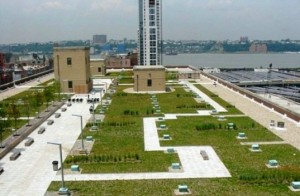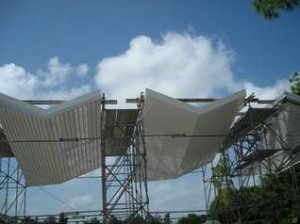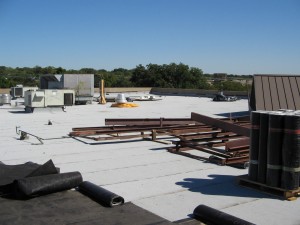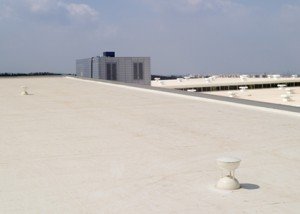Archive for July, 2010
USPS Delivers Huge Energy Savings
The largest of its kind, a 2.5 acre green roof sits on top of the Morgan Mail processing facility in Manhattan. The year old green roof is expected to last 50
years, twice as long as the previous roof. Cutting energy consumption by 40% and saving more than $1 million. The green roof is also reducing storm water runoff in summer by 75% and in winter by 40%.
Combined with other green building practices, such as implementing solar rooftop panels in some facilities, replacing 16,000 windows and an entire fleet
of alternative fuel vehicles, the postal service has cut energy intensity by 21% since 2003. The USPS is already 2/3 of the way towards its 2015 goal of decreasing energy use by 30%.
Some other measures the postal service has taken is implementing an energy management system and a team of postal experts that conduct facility audits and provide energy solutions and cost effective alternatives for each facility.
The United States Postal Service is leading the way in green energy, winning more than 75 environmental awards from The White House and the Environmental Protection Agency as well as being certified by LEED (Leadership in Energy and Environmental Design).
Chicago's Green Roof City Hall
It has been nine years since Chicago’s Mayor, Richard Daley, announced there would be a ‘green roof’ laid on top of the City Hall. Back then, his fellow advisories and colleagues thought he had gone mad!
The 20,000 sq ft garden sits atop the 12 story building. Since having the green roof, every year the total energy costs for the whole City Hall have seen a $5,000 reduction. Mainly because the plants and grass absorb the sun’s rays through the summer months, and insulate the building in the winter months. Also, the plants absorb around 60% of the rain-water which lands on the roof; this offsets the costs of paying local businesses that control the runoff of storm water.
Back in 2001, this was a brave move for the City Hall, but as more and more people see the amount of savings, more and more people have decided to give the green roof a go. For example, Scott and Ruth McElroy from Vancouver invested in a $4,000 roof and immediately saw a $25 reduction in their monthly energy costs.
It’s not just the residents and government offices who have joined in with the green craze; Ford Motor Company assembly plant in Michigan has an extraordinary 10 acres of vegetation spanning their rooftops. If one of the largest car firms in the world are benefiting from not only reducing energy costs, but helping to protect and bolster the environmental impact of factories and the concrete jungle of cities, then it is about time all of us consider that route.
Mayor Daley stated that the government bodies were always pointing their fingers at businesses and residential areas, but he was a pioneer in looking at the impact of his own offices. By tackling environment issues, and taking a stance using a green roof on top of the City Hall, this is a perfect way of leading by example. Nowadays, schools, libraries and general stores are all jumping on the green roof bandwagon and this is only having a positive effect on the environment.
Enter the Flexible Solar Panel
For some, solar panels are an eye-sore, regardless of the energy-saving qualities, the reduction in the reliance of the National Grid and being a drain on fossil-fuel energy. As technology advances, especially as photovoltaics are one of the fastest growing technologies of this last decade, the design and structure of panels are always changing.
Enter the flexible solar panel. With the cost of glass-encased solar panels being expensive, added to the expense of fitting them, some companies nowadays are producing flexible panels to be stuck to roof tops with adhesive.
These lightweight film-like panels still look like normal photovoltaics, but without the bulkiness. As with many modern technologies, such as mobile phones and TVs, the slimmer the package means less transport costs per unit and les storage costs, which can then be passed on to the final selling price.
The film panels can be laminated onto the roof of businesses, flat roof factories, and pretty much anywhere normal panels can go. The rate of efficiency is only around 11%, although tests with CIGS (a combination of copper, indium, gallium and selenium) cells, the highest recorded efficiency rating has been 15%. The market average of ‘normal’ solar panel efficiency across the many companies making them is between 12-18% with only a handful reaching 20+%.
With lower costs, and easier fitment which can be completed more quickly, these film-strip solar panels could replace the heftier solar panels. Being more accessible, everyday home-owners could purchase these solar panels, not just the multi-million dollar businesses who always sign a power-purchase agreement with the government and electrical suppliers before investing.
This accessibility will have a more positive effect on the environment, rather than one which offsets enormous energy waste, such as those large factories. Now it is time to increase the amount of solar panels on roofs and make them a majority.
Harvesting Rainwater
America is one of the very few countries in the world that uses drinking water to water the gardens, plants and trees. This would seem crazy to inhabitants in the majority of the world. A recent advocate of rainwater harvesting, Bob Dailey who is a gardener at The Woodlands Parks and Recreation Center said, “ I can’t believe we didn’t do this sooner…we are losing millions of gallons of water each day”.
The Center began collecting rainwater, of which is around 43 inches per year, and is kept in a 2,500 gallon container. Each year, the Center’s roof can collect around 620 gallons of water which would be enough to fill a swimming pool, water the gardens, and keep the plants healthy.
The switch to using rainwater is becoming more popular, especially since the cost of drinking water is on the rise. In many other areas of the globe, showering, tap water and hose-pipes use recycled rainwater, and why not?
This obsession with wasting water, which comes from the skies for free, needs to be quashed. Motorists in Mr. Daley’s city complained of the excess water during storms, claiming it to be very difficult to drive through. Irrigation also plays a part, by collecting rainwater, the run-off into sewers is reduced, making it less of a strain on drainage systems, reducing the chances of contaminating with sewerage and drinking water and best of all it’s free.
With more and more towns and cities depleting their groundwater supplies, and calls for hosepipe bans during the dry seasons, collecting rainwater suddenly seems such an easy way to stop this. Of course, the cost of the container and guttering will be the original cost, but this will offer years of free water and keep the urban jungle from becoming flooded with its impermeable concrete layers.
"10 Million Solar Roofs" Bill
Vermont Senator, Bernie Sanders, plus 11 colleagues introduced the act, 10 Million Solar Roofs, arguing that it will create energy independence. The policy will also aid in cutting air and water pollution and reducing greenhouse gas emissions, while creating new green jobs and putting America in the forefront of the global solar power industry.
The aggressive solar policy was approved by Senate Committee on Energy and Natural Resources on Wednesday. Senator Sanders hopes to include his bill in a package that is expected to be before the Senate later this summer.
The 10 Million Solar Roofs bill would fund solar installations through competitive grants. $250 million in grants would be approved in 2012. And between 2013 and 2021, $500 million would be provided annually. Using consumer rebates for purchase and installations of solar systems.
The bill’s ultimate goal is over the next 10 years for 10 million new solar rooftop systems and 200,000 new solar water heating systems to be installed in the United States. The total current US solar energy capacity will be tripled when the bill is fully integrated. If it becomes a law, than going solar will be even more cost efficient for Americans and a step forward towards a clean energy future.
Sneak Peak at Red Sox Roof
3 mock up panels of the roof for the new Boston Red Sox spring training stadium are perched high on scaffolding in the adjacent lot. The mock up panels are the same design from the drawings and are on display for approval by the Red Sox and Lee County.
Kraft construction assembled the panels and will be the firm that will build the $80 million spring training complex. The ballparks seating capacity will be 11,000 and is expected to be completed in time for the spring training in 2012.
The facility will be built on Daniels Parkway in Ft. Myers Florida near the Southwest Florida International Airport. Ft. Myers in Lee County has been home to the Boston Red Sox for spring training since 1993.
A Simple Yet Effective Way of Stabilizing the Climate
A recent study by a National Center for Atmospheric Research scientist has found evidence to suggest that to stabilize the climatic differences between city center temperatures compared to rural, is to paint buildings roofs white.
This simple yet very effective practice can help reduce the city’s temperature by 1 degree Fahrenheit. For every degree, this helps keep the climate for that city and indeed surrounding area at a more even kilter.
Keith Oleson, the lead scientist and author of the study said, “In theory, our research has shown an effective method of slowing urban heat”. This urban heat is exacerbated by the solid concrete blocks, roads and buildings, which absorb heat, making the ambient temperature rise and thus having a detrimental affect on the climate.
By painting roofs white, as is very popular in Europe particularly Spain and Greece, you allow the sun’s infrared light to pass through the roof insulation. By having white roofs, the urban heat island effect, as it is know, could be reduced by a 1/3 having a positive effect of reducing city’s temperatures. The trial is being tested in cities such as Washington D.C and Seattle, where during the summer months, the temperatures can rise to much higher levels than that of their rural neighbors.
US Energy Secretary Steven Chu is said to be backing the idea and wants the idea rolled out in more major cities throughout the USA. As the rate of greenhouse gases being expelled is still rising, this simple amendment can negate some of the intensity of the damaging affects.
By painting roofs white, this would reduce the world’s cities temperatures by around 0.7 degree Fahrenheit (or 0.4 degrees Celcius) which would bring the pronounced heat of city life down during the summer months especially. In a bid to do everything and anything to slow the rising temperature of the world’s temperature, painting you roof white seems to be one of the easiest.
Cool Roofs Cut Emissions and Cool Climate
Rooftops and roads lighter in color can help reduce carbon dioxide emissions and slow climate change says scientists at Lawrence Berkeley National Laboratories in California. Significantly cutting emissions and combating global climate change by cooling cities and the world, researchers say. ScienceDaily.com reported that cool roofs and cool pavements in cities around the world could cancel the heating effects of up to 2 years of worldwide carbon dioxide emissions.
Cool roofs are one of the quickest and lowest cost ways we can reduce our global carbon footprint. Increasing the reflectivity of roof and pavement materials in cities with population greater than 1 million would achieve a one time offset of co2 emissions double the worldwide co2 emissions levels in 2006. Cool roofs have worked for thousands of years in Mediterranean and Middle Eastern cities where demand for air conditioning is low.
Cool roofs deliver high solar reflectance, reducing the heat transfer to the building. Enhancing roof durability and reducing building cooling needs and the urban heat island effect. The surface of a black roof can increase roof temperatures as much as 90 degrees Fahrenheit. Cool roofs have a typical heat increases of 10-25 degrees Fahrenheit above ambient temperature during the day. There are three types of cool roofs:
- Inherently cool roofs; made of thermoplastic white vinyl, white reflective membranes.
- Coated roofs; ceramic coatings or high performance nanotechnology heat reflective paints.
- Green roofs; typically consisting of an insulation layer, waterproof
membrane, drainage layer, growing medium and plants.
Black roofs are preferable in cooler climates, where more energy is produced to heat the house than to cool it. Green roofs are a good option for cooler climates with a flat roof.
Roof Vent Designed to Catch Wind
Two brothers, Pat and Chuck Johnson, US roofing company Acrylife, and Virginia Tech research team designed an omni directional roof vent to help preserve reflective roof membranes (cool roofs), as well as conventional roofs from being lifted off or torn from wind damage. Low pitched membrane roofs are the main systems this vent was designed for.
The omni directional vent is designed to capture wind from every direction and then produces suction that keeps the roof membranes in place. The wind is constricted, making it more dynamic as it enters the lower half of the vent and then it is forced upward, this strong wind stream removes air below in the roofing system causing a powerful suction effect.
Chuck and Pat Johnson, principals at Acrylife, came up with the idea in 2002. They took their idea to Virginia Tech College of Architecture and Urban Studies and College of Engineering research team to help them test and develop the idea.
Acrylife has been using a version into its’ roofing systems it calls Venturi Vent Technology, V2T. The research team is focused on bringing a low cost version that can be commercially manufactured. They are also looking at issues surrounding the use of the vent that will aid roof installers and manufacturers, such as the correct spacing of the vents, and how the vents react to different roof membranes and insulation.
New PV Certification and Training Program
NRCA and the Center for Environmental Innovation in Roofing have created Roof Integrated Solar Energy inc. (RISE). Providing a way to evaluate and certify solar roofing professionals in the extensive use of rooftop photovoltaic systems and solar energy.
Evaluating and certifying solar energy installers, RISE assessing the knowledge of roof construction and after care practices necessary to support successful rooftop solar energy.
The voluntary certification is for individuals who successfully complete the requirements established by RISE certified Solar Roofing Professional (CSRP) certification. Candidates will be asked to demonstrate basic knowledge about different photovoltaic systems combined with electricity, installation guidelines, building codes and after the installation follow up.
For more information on training or certification please visit www.riseprofessional.org















